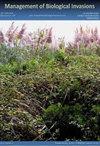Efficacy, non-target impacts, and other considerations of unregistered fipronil-laced baits being used in multiple invasive ant eradication programs
IF 1.2
4区 环境科学与生态学
Q3 BIODIVERSITY CONSERVATION
引用次数: 1
Abstract
We present three studies assessing the efficacy and non-target impacts of multiple unregistered forms of hydrogel ant baits, as well as some co-use with the granular bait Antoff, that were experimentally used targeting Argentine ant, Linepithema humile, and yellow crazy ant, Anoplolepis gracilipes, within natural/semi-natural environments in Australia. The three studies varied greatly in design and treatment regimens, and were each conducted to address real-time learning needs while attempting to understand how best to use these experimental baits within the spatial, temporal and logistic limitations of three eradication programs. All studies involved broadscale applications of numerous forms of the baits, with greatly varying treatment regimens, coupled with before-after sampling of ant communities, as well as other soil invertebrates in one study. All studies found the baits were highly efficacious against both species, more so for A. gracilipes than L. humile . Eradication is considered to have been achieved for A. gracilipes in one treatment area with a triple treatment regimen, but not using different treatment regimens in other areas. Six treatments conducted approximately one week apart did not eradicate L. humile . Few non-target impacts were found, predominantly occurring only when sampling was conducted within days of a treatment, or at the end of six treatments of a high application rate. Instead, non-target species richness and composition were most often more affected by spatial location or sample time than treatment. Any treatment effects were non-persistent after 6–18 months. Hydrogel baits are likely to have significant roles to play for ant management and eradication.在多种入侵性蚂蚁根除计划中使用未登记的含氟虫腈诱饵的功效、非目标影响和其他考虑因素
本文介绍了在澳大利亚的自然/半自然环境中,对多种未注册形式的水凝胶蚂蚁饵料以及一些与颗粒饵料Antoff共同使用的效果和非靶向影响进行了三项研究,这些饵料被实验用于针对阿根廷蚂蚁(Linepithema humile)和黄狂蚂蚁(anplolepis gracilipes)。这三项研究在设计和治疗方案上有很大的不同,每项研究都是为了解决实时学习需求,同时试图了解如何在三个根除计划的空间、时间和逻辑限制下最好地使用这些实验诱饵。所有的研究都涉及广泛应用多种形式的诱饵,有很大不同的治疗方案,再加上蚂蚁群落的前后采样,以及在一项研究中其他土壤无脊椎动物。所有的研究都发现,这些诱饵对这两种物种都非常有效,对细叶蝉比矮叶蝉效果更好。据认为,在一个治疗地区,采用三联治疗方案已实现了对细腹支原体的根除,但在其他地区未采用不同的治疗方案。大约间隔一周进行的六次处理并没有根除谦卑乳杆菌。很少发现非目标影响,主要发生在处理后几天内进行抽样时,或者在高施用量的六次处理结束时。相反,非目标物种丰富度和组成最常受空间位置或采样时间的影响,而不是处理。6-18个月后,任何治疗效果都不持久。水凝胶诱饵可能在蚂蚁管理和根除方面发挥重要作用。
本文章由计算机程序翻译,如有差异,请以英文原文为准。
求助全文
约1分钟内获得全文
求助全文
来源期刊

Management of Biological Invasions
Agricultural and Biological Sciences-Ecology, Evolution, Behavior and Systematics
CiteScore
3.40
自引率
6.70%
发文量
21
审稿时长
16 weeks
期刊介绍:
Management of Biological Invasions, established in 2010 by Dr. Elias Dana, is an open access, peer-reviewed international journal focusing on applied research in biological invasions in aquatic and terrestrial ecosystems from around the world. This journal is devoted to bridging the gap between scientific research and the use of science in decision-making, regulation and management in the area of invasive species introduction and biodiversity conservation.
Managing biological invasions is a crisis science, with Management of Biological Invasions aiming to provide insights to the issues, to document new forms of detection, measurements and analysis, and to document tangible solutions to this problem.
In addition to original research on applied issues, Management of Biological Invasions publishes technical reports on new management technologies of invasive species and also the proceedings of relevant international meetings. As a platform to encourage informed discussion on matters of national and international importance, we publish viewpoint papers that highlight emerging issues, showcase initiatives, and present opinions of leading researchers.
 求助内容:
求助内容: 应助结果提醒方式:
应助结果提醒方式:


